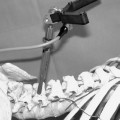
Videotactic Surgery: A Volume as an Image-Guided Target
When computed tomography (CT) and then magnetic resonance imaging (MRI) were introduced, it was only natural that such sophisticated imaging techniques be combined with stereotactic surgery to allow surgeons to target accurately in space any mass that could be visualized.1 As computer graphics became more accessible, techniques for reconstructing three-dimensional (3-D) images of the brain and any mass therein allowed unprecedented visualization of brain structures. The use of sophisticated 3-D images for accurate localization in the operating room is only now evolving, in part because of the limited ability of 2-D computer displays to deliver complex 3-D graphic images to the surgeon.
The programs described below address the problems of (1) how to get the maximum amount of information to facilitate surgical judgment, (2) how to process this information to define the target for resection as a unified volume, rather than merely a series of single points in space, and (3) how to display this information to the surgeon in an intuitive and useful manner, incorporating the computer-generated guidance graphic into a real-time view of the operating field throughout the resection.
The Exoscope program was developed to provide a real-time image of the operating field with a superimposed, computer-generated image of the target volume, usually a tumor. This augmented reality guides the surgeon to the tumor and demonstrates graphically the preplanned resection line to facilitate accurate resection.2
 Concepts of Defining a Target in Space
Concepts of Defining a Target in Space
Since the advent of stereotactic surgery and then imageguided surgery, it has been standard procedure to use a point in space as the target. Stereotactic frames guide a probe to a specific point localized in three dimensions. Stereotactic procedures work because they superimpose that point with the intended target. A stereotactic frame is mechanically applied to the patient’s skull so that any structure therein is registered to stereotactic space. The images are then acquired, and any target or structure on those images is likewise oriented stereotactically. Thus the target might be a point from a CT- or MRI-visualized mass to be biopsied, a point in an anatomical structure such as the globus pallidus to be lesioned, or a point at the center of a landmark such as the anterior or posterior commissure from which an ultimate target is indirectly localized. In all these cases, the target is one or several points in space.3
Point-in-space targeting
Frameless image-guided surgery also uses a point in space as a target, or, more commonly, a series of points.4 Even though the display of a frameless system might show a beautifully rendered, 3-D picture of the volume of the patient’s head and the tumor within, that impressive image is generally not as useful to the surgeon as images showing the position of a pointer’s tip in space. The point is oriented to 3-D space by the simultaneous display of three CT or MRI reconstructed slices. Each 2-D slice demonstrates the position of the probe tip. The surgeon mentally combines the 2-D images to appreciate the 3-D position of the tip of the pointer. By identifying a number of points in space in this fashion, the surgeon builds a mental picture of the edge of the tumor and consequently the volume within.5–6
Stereotactic frames can be used to define the outline of a volume in a similar fashion. A series of points are selected on the CT or MRI console or on the surgical planning workstation so that they represent the edge of the volume, whether it is a tumor or a line of resection around the tumor. Three-dimensional stereotactic coordinates [anteroposterior (AP), lateral, vertical] are determined for each point. By readjusting the stereotactic frame repeatedly, each of those points can be defined in the surgical field, and thus an approximation of the target volume can be obtained.
This principle can be illustrated by defining the volume of a cube in space. If you know it is a cube and you define one point on each of the six surfaces, the volume of that cube is accurately contained within those six points. A similar technique using six points can be employed to approximate the volume of a tumor, although errors are introduced because of irregularities in the shape of the tumor.
Volume-in-space targeting
Even though it is possible to build or develop a 3-D volume as a virtual target, there remains the problem of delivering that information to the surgeon in the simplest and most useful fashion. Such 3-D volumetric targeting is necessarily used in stereotactic radiosurgery, where the treatment volume must be defined. The actual targeting is done by displaying individual slices through the target volume, and the target or surface of the volume is designed slice by slice. The target volume or isodose volume may be displayed as a translucent rendered picture or on a 2-D display to provide the surgeon with the perception of seeing either a 3-D volume or a series of 2-D slices.7–8
Presenting three-dimensional information to the surgeon
How can 3-D volumetric information be presented to the surgeon during an image-guided procedure in the simplest and most useful manner? Because computer displays are 2-D, one possibility is to present the images in multiple views and allow the surgeon to mentally reconstruct the volume. Although this technique is simple enough for point-in-space targeting, there is too much information for even a neurosurgeon to process efficiently.
Another possibility is to present the information stereoscopically, to provide the surgeon with the perception of seeing a 3-D image. The problem then becomes how to register that perception to its location in the surgical field because it is a volume that is intuitively reconstructed in the human brain and not necessarily a true reflection of a solid. Such perceptions result from presenting two 2-D pictures taken from a perspective several degrees apart as viewed by each eye individually. That is the basis for the nineteenth-century stereopticon and the 3-D horror movies of the 1950s. One must be careful that the pictures were taken from the same perspectives as each of the viewer’s eyes, or the depth will be either foreshortened or elongated.
The classical application of well-controlled stereoscopic vision is in the operating microscope, where a magnified 3-D picture of the surgical field is visualized. Not only does it permit an excellent view of the surgical field, it is also possible to inject a superimposed image in the surgeon’s line of sight with a so-called heads-up display. (Certain military aircraft have flight or target information projected onto the windshield so that pilots can receive the information without looking down to the control panel—heads up). Such displays are 2-D, but the display can consist of a series of slices that form a volume when stacked one on the other.9–10
History
Kelly et al first introduced the concept of 3-D volumetric image-guided neurosurgery in the mid-1980s.11 Kelly’s Compass system at that time consisted of a large computer workstation that allowed the surgeon to define the tumor volume in three dimensions and a stereotactic frame that made it possible to localize that volume in stereotactic space.12 The surgeon outlined the border of the mass in each CT or MRI slice. The computer stacked the slices to define the volume and then interpolated between slices to render the surface so the picture of a volume could be seen on the console. Because the images were taken with the stereotactic frame in place, it was possible to localize the volume accurately within the head. The biggest problem was to present that information to the surgeon. Kelly solved the problem by mounting a cylindrical retractor on the stereotactic frame so it pointed directly at the tumor. The computer displayed the outline of the tumor and also a surrounding circle to represent the retractor. When the operating microscope was properly aligned, the outline of the tumor was seen superimposed on the view of the surgical field. There were problems in that the retractor restricted access, so most resection had to be done with a cardon dioxide (CO2) laser. Most gliomas are larger than the retractor diameter, so it was necessary to use several targets and shift the retractor during the resection. The vertical dimension or depth along the surgeon’s line of sight was not initially indicated, but later versions outlined only part of the tumor at a time to provide the third dimension.12–13
Other systems have built on this concept and display the targeting information through an operating microscope. The Zeiss MKM system (Thornwood, NY) has used similar display techniques but with more refinement. 10 The position of the microscope in space is identified using frameless localizing techniques, so it is not necessary to use a stereotactic frame. The outline of the tumor is updated as resection progresses, and only the outline at a given depth is displayed.
Stay updated, free articles. Join our Telegram channel

Full access? Get Clinical Tree





